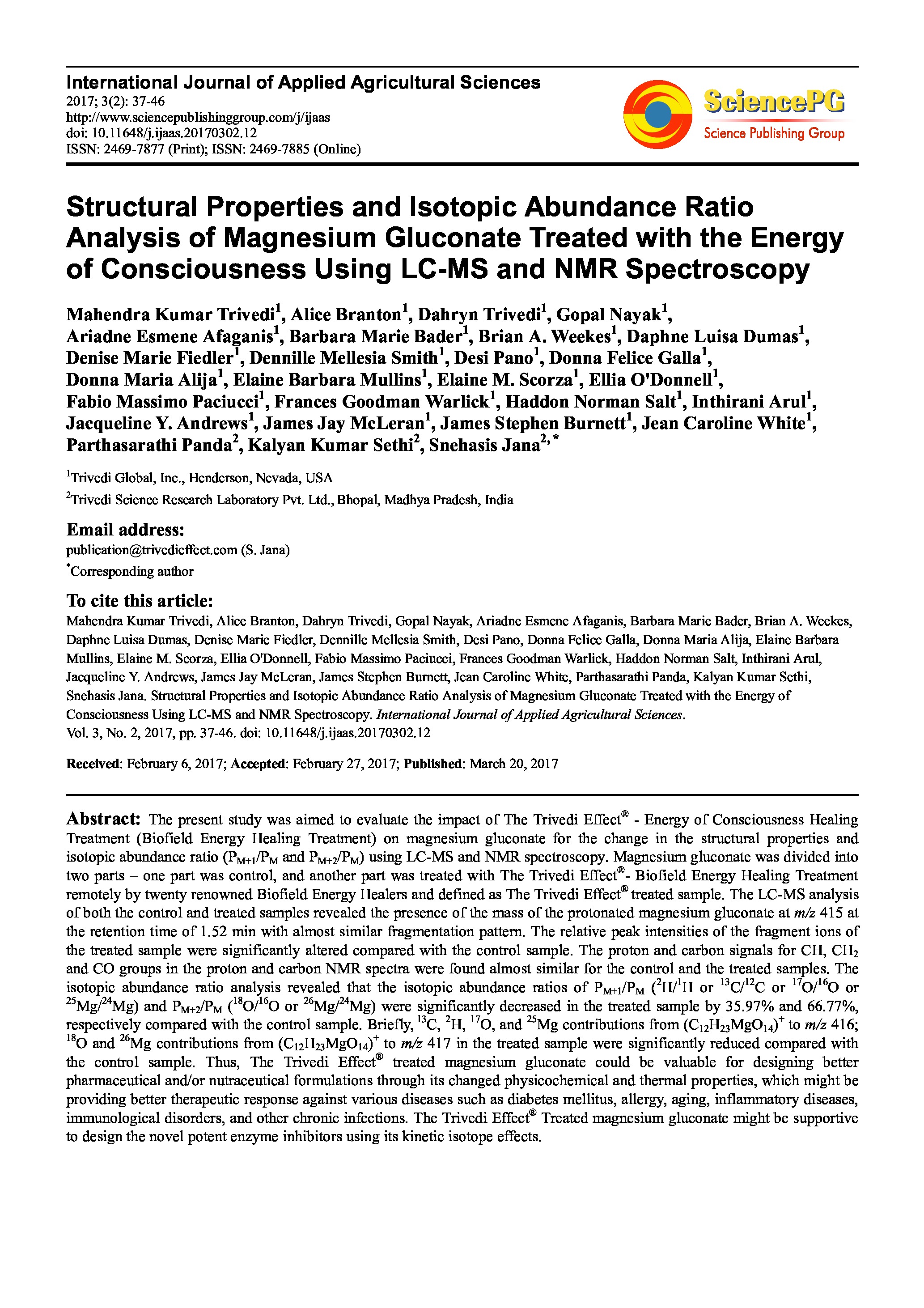Structural Properties and Isotopic Abundance Ratio Analysis of Magnesium Gluconate Treated with the Energy of Consciousness Using LC-MS and NMR
Co-author
Mahendra Kumar Trivedi, Dahryn Trivedi, Gopal Nayak, Ariadne Esmene Afaganis, Barbara Marie Bader, Brian A. Weekes, Daphne Luisa Dumas, Denise Marie Fiedler, Dennille Mellesia Smith, Desi Pano, Donna Felice Galla, Donna Maria Alija, Elaine Barbara Mullins, Elaine M. Scorza, Ellia O'Donnell, Fabio Massimo Paciucci, Frances Goodman Warlick, Haddon Norman Salt, Inthirani Arul, Jacqueline Y. Andrews, James Jay McLeran, James Stephen Burnett, Jean Caroline White, Parthasarathi Panda, Kalyan Kumar Sethi, Snehasis Jana
Affiliation
Trivedi Global Inc.; Trivedi Science Research Laboratory Pvt. Ltd.
Main category
Natural Sciences (Analytical Chemistry, Method Development (Chemistr)
Abstract
The present study was aimed to evaluate the impact of The Trivedi Effect® - Energy of Consciousness Healing Treatment (Biofield Energy Healing Treatment) on magnesium gluconate for the change in the structural properties and isotopic abundance ratio (PM+1/PM and PM+2/PM) using LC-MS and NMR spectroscopy. Magnesium gluconate was divided into two parts – one part was control, and another part was treated with The Trivedi Effect®- Biofield Energy Healing Treatment remotely by twenty renowned Biofield Energy Healers and defined as The Trivedi Effect® treated sample. The LC-MS analysis of both the control and treated samples revealed the presence of the mass of the protonated magnesium gluconate at m/z 415 at the retention time of 1.52 min with almost similar fragmentation pattern. The relative peak intensities of the fragment ions of the treated sample were significantly altered compared with the control sample. The proton and carbon signals for CH, CH2 and CO groups in the proton and carbon NMR spectra were found almost similar for the control and the treated samples. The isotopic abundance ratio analysis revealed that the isotopic abundance ratios of PM+1/PM (2H/1H or 13C/12C or 17O/16O or 25Mg/24Mg) and PM+2/PM (18O/16O or 26Mg/24Mg) were significantly decreased in the treated sample by 35.97% and 66.77%, respectively compared with the control sample. Briefly, 13C, 2H, 17O, and 25Mg contributions from (C12H23MgO14)+ to m/z 416; 18O and 26Mg contributions from (C12H23MgO14)+ to m/z 417 in the treated sample were significantly reduced compared with the control sample. Thus, The Trivedi Effect® treated magnesium gluconate could be valuable for designing better pharmaceutical and/or nutraceutical formulations through its changed physicochemical and thermal properties, which might be providing better therapeutic response against various diseases such as diabetes mellitus, allergy, aging, inflammatory diseases, immunological disorders, and other chronic infections. The Trivedi Effect® Treated magnesium gluconate might be supportive to design the novel potent enzyme inhibitors using its kinetic isotope effects.
Do you have problems viewing the pdf-file? Download paper
here
If the paper contains inappropriate content, please
report the paper. You will be redirected to the landing page.
